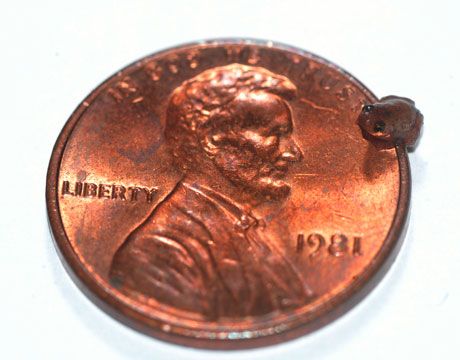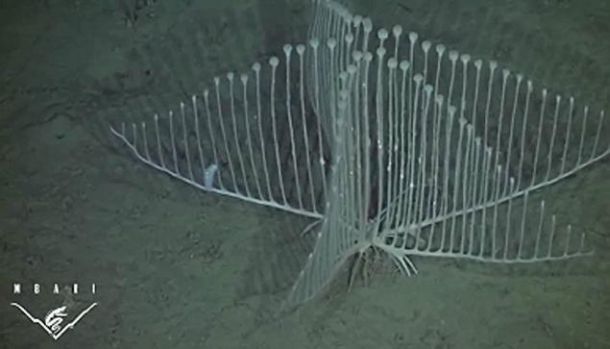Even as many species are threatened with extinction, scientists continue to discover fascinating new creatures all over the world.
Some of these discoveries are particularly fascinating. Here are 10 of the most bizarre animals recently discovered and identified by scientists.
10. Vampire Flying Frog

Vampire Flying Frog (Photo credit: Australian Museum)
This recently discovered animal is a just one of over 1,000 new species recently discovered in the Mekong region of Vietnam by the World Wildlife Fund (WWF). It may look like an ordinary frog in the picture above, but it carries its name because it has a pair of vampire-like fangs in its mouth when its a tadpole.
The Vampire Flying Frog can’t actually fly and it doesn’t suck blood, but it can glide through the forest canopy using its webbed toes.
9. Microhyla nepenthicola

A "pea-sized" frog (Photo credit: Conservation International)
This “pea-sized” frog was discovered in Borneo in 2010. When scientists first spotted it in a pitcher plant (a type of carnivorous plant), they originally thought it was a baby. They soon realized that even the largest males of this tiny species barely grow to 1/2 inch in length. Its now believed to be the smallest frog outside of the Americas.
8. Leaf Deer

Leaf Deer (Photo credit: Alan Rabinowitz | WWF Nepal)
The leaf deer was first discovered in 1997 by biologist Alan Rabinowitz. Although this might look like a baby, its actually an adult leaf deer. Leaf deer are the world’s smallest dear and live in Myanmar. They’re approximately 2.5 feet in height and weigh around 25 lbs. The leaf deer got its name because local hunters could wrap the deer’s body in a large leaf.
7. Crystal Frog

Glass Frog (Photo credit: Luis Coloma / Conservation International)
For many years, scientists were unable to explore the ecologically rich jungle on the border of Peru and Ecuador due to a violent armed conflict. When they did finally have the opportunity to explore the area in 2009, they found a rich ecosystem bustling with yet-to-be discovered species.
Among the weird animals found was the crystal frog. The crystal frog’s skin was completely translucent, so translucent you could even see its heart beating through its skin.
6. Ugly Salamander

"Ugly" Salamander (Photo credit: Jessica Deichmann / Conservation International)
When this little salamander was first discovered, it was known only as the ugly salamander. So far the name has stuck. Is this little guy ugly, or is just reminiscient of a tiny little E.T.? You be the judge.
5. Pliosaurus Funkei

An artist's rendering comparing the Pliosaur Funkei to a human diver, a blue whale, and an orca. (Photo credit: or Sponga, Bergens Tidende)
Unlike the other discoveries on this list, this giant marine reptile has been extinct for approximately 150 million years. However, when it was in its prime the Pliosaurus Funkei was a 40 foot long beast with a 6.5 foot long skull that could bite 4 times as hard as the T-rex. It was the top predator in the ocean in a time period where the ocean was teaming with monsters.
The Pliosaurus was discovered in 2006 when scientists in Svalbard, Norway unearthed 2 massive fossilized skeletons of the extinct marine giant. At the time, it was only known as Predator X. According to paleontologist Patrick Druckenmiller, “They had teeth that would have made a T. rex whimper”.
4. Harp Sponge

Harp Sponge (Photo credit: Monteray Bay Research Aquarium Institute)
This beautiful, plantlike creature looks more like an elegant candelabra or a harp than a fierce carnivore. But make no mistake about it, this meat-eating sponge discovered in 2000 feeds by letting the ocean currents draw helpless crustaceans into their tentacles.
This carnivorous sponge was named the “Harp Sponge” because it looks a lot like a harp placed on its side. It was discovered almost 2 miles under the ocean surface off the coast of Monterey Bay in California, by scientists from the Monterey Bay Aquarium Research Institute (MBARI).
3. Ice Fish

A young Antarctic Icefish (Photo credit: Peter Bucktrout | British Antarctic Survey)
The Ice Fish, or Chaenocephalus aceratus, is aptly named. They live in the icy depths of the Southern Ocean by Antarctica. These fish have a type of natural anti-freeze flowing through their veins rather than red blood cells.
2. Sea Pigs

Antarctic Sea Pig (Photo credit: Peter Bucktrout | British Antarctic Survey)
The sea pig looks like a set of cow udders floating around in water. While they may appear alien and unfamiliar to the average person, they’re actually one of the most common creatures in the ocean depths surrounding Antarctica.
1. Phallostethus Cuulong

Phallostethus cuulong seen from (a) dorsal (b) lateral, (c) ventral views. (Photo credit: L.X. Tran, Zootaxa)
This recently discovered fish was found in Vietnam. It tops our list as the most weird creature found in recent years thanks one prominent feature - it has a penis on its head.
Yes, this unfortunate (or fortunate, depending on how you look at it) little fish has a penis hanging beneath its chin. To make things more complicated, the penis has a jagged hook used to grab onto females during coitus.
The technical name for the penis on the male fish’s head is priapium. In addition to the penis and jagged hooks, it also houses the fish’s anus. Interestingly, the female’s genital opening is also located in on her head, under the throat.